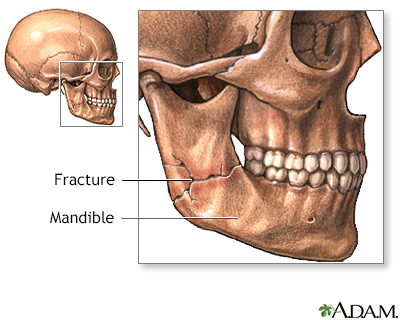Pregnancy SmartSiteTM
Dislocated jaw; Fractured jaw; Fractured mandible; Broken jaw; TMJ dislocation; Mandibular dislocation DefinitionA broken jaw is a break (fracture) in the jaw bone. A dislocated jaw means the lower part of the jaw has moved out of its normal position at one or both joints where the jaw bone connects to the skull (temporomandibular joints). A jaw bone joint is called the temporomandibular joint (TMJ). ConsiderationsA broken or dislocated jaw usually heals well after treatment. But the jaw may become dislocated again in the future. Complications may include:
CausesThe most common cause of a broken or dislocated jaw is injury to the face. This may be due to:
SymptomsSymptoms of a broken jaw include:
Symptoms of a dislocated jaw include:
First AidA person with a broken or dislocated jaw needs medical attention right away. This is because they may have breathing problems or bleeding. Call 911 or the local emergency number or a local hospital for further advice. Hold the jaw gently in place with your hands on the way to the emergency room. You can also wrap a bandage under the jaw and over the top of the head. The bandage should be easy to remove in case you need to vomit. At the hospital, if you have breathing problems, heavy bleeding occurs, or severe swelling of your face, a tube may be placed into your airway to help you breathe. FRACTURED JAW Treatment for a fractured jaw depends on how badly the bone is broken. If you have a minor fracture, it can heal on its own. You may only need pain medicines. You will probably have to eat soft foods or stay on a liquid diet for a while. Surgery is often needed for moderate to severe fractures. The jaw may be wired to the teeth of the opposite jaw to keep the jaw stable while it heals. Jaw wires are usually left in place for 6 to 8 weeks. Small rubber bands (elastics) are used to hold the teeth together. After a few weeks, some of the elastics are removed to allow motion and reduce joint stiffness. If the jaw is wired, you can only drink liquids or eat very soft foods. You must have blunt scissors readily available to cut the elastics in the event of vomiting or choking. If the wires must be cut, call your health care provider right away so that the wires can be replaced. DISLOCATED JAW If your jaw is dislocated, the provider may be able to place it back into the correct position using the thumbs. Numbing medicines (anesthetics) and muscle relaxants may be needed to relax the jaw muscles. Afterward, your jaw may need to be stabilized. This usually involves bandaging the jaw to keep the mouth from opening widely. In some cases, surgery is needed to do this, particularly if repeated jaw dislocations occur. After dislocating your jaw, you should not open your mouth widely for at least 6 weeks. Support your jaw with one or both hands when yawning and sneezing. Do NotDo not try to correct the position of the jaw. A provider should do this. When to Contact a Medical ProfessionalA broken or dislocated jaw requires prompt medical attention. Emergency symptoms include difficulty breathing or heavy bleeding. PreventionDuring work, sports, and recreation activities, using safety equipment, such as a helmet when playing football, or using mouth guards can prevent or minimize some injuries to the face or jaw. ReferencesKellman RM. Maxillofacial trauma. In: Flint PW, Francis HW, Haughey BH, et al, eds. Cummings Otolaryngology: Head & Neck Surgery. 7th ed. Philadelphia, PA: Elsevier; 2021:chap 20. Mayersak RJ. Facial trauma. In: Walls RM, ed. Rosen's Emergency Medicine: Concepts and Clinical Practice. 10th ed. Philadelphia, PA: Elsevier; 2023:chap 34. | ||
| ||
Review Date: 4/3/2025 Reviewed By: Ashutosh Kacker, MD, FACS, Professor of Clinical Otolaryngology, Weill Cornell Medical College, and Attending Otolaryngologist, New York-Presbyterian Hospital, New York, NY. Review provided by VeriMed Healthcare Network. Also reviewed by David C. Dugdale, MD, Medical Director, Brenda Conaway, Editorial Director, and the A.D.A.M. Editorial team. View References The information provided herein should not be used during any medical emergency or for the diagnosis or treatment of any medical condition. A licensed medical professional should be consulted for diagnosis and treatment of any and all medical conditions. Links to other sites are provided for information only -- they do not constitute endorsements of those other sites. No warranty of any kind, either expressed or implied, is made as to the accuracy, reliability, timeliness, or correctness of any translations made by a third-party service of the information provided herein into any other language. © 1997- A.D.A.M., a business unit of Ebix, Inc. Any duplication or distribution of the information contained herein is strictly prohibited. | ||


 Mandibular fractur
Mandibular fractur
